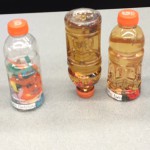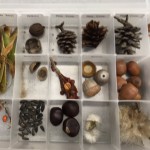By Angie Andre
Tredyffrin Public Library
Children’s Librarian
Science, technology, engineering, art, and math, this is STEAM as we know it. What does this look like when we break it down into doable programs that are inexpensive, interesting, interactive, and passive? I am going to share 6 passive programs that can easily be created and implemented in your library to support STEAM and Basic Literacy.
Collect things you find in nature, put them in a box and label each item and you have a Nature Discovery Box.
Children can touch and learn the names of items found nature.
You could also challenge the children to guess what the items are and not label them.
Either way we are encouraging discovery using senses.
2. Engineering with spaghetti and marshmallows:

Offer marshmallows and uncooked spaghetti for children to engineer their own creations.
This can be a project that friends build on as the days go by.
It could also be a contest to see who can build the largest structure.
3. Science in a bottle:
Save a few clear water bottles, remove the labels and you have the basics for science in a bottle.
 a. Magnets: fill a bottle with metal and not metal items. Children can use a magnet to see which items they can make move.
a. Magnets: fill a bottle with metal and not metal items. Children can use a magnet to see which items they can make move.
b. Static electricity: Fill this bottle with small pieces of tissue paper, secure the top, and rub bottle on carpet or clothing to charge.
c. & d. Explore viscosity by using 2 bottles, one bottle filled with syrup and the other filled with water. Drop a marble in each bottle and secure the top. Children can explore and learn about the movement of objects through different types of liquid.
e. Tornado in a bottle: Fill a bottle with water and leave a little space at the top. Squirt dishwashing liquid into the bottle and secure the top. Shake bottle with a twisting motion to create a tornado.
4. Counting Jars:
 Give children a chance to count and estimate in a fun way. The one who estimates closest to the actual total wins the contents of the jar. This passive activity is easy and fun. If you do a few in a row, children look forward each week to see what is out for them to count. We try to stay away from candy but the grand finale is jelly beans. There are many inexpensive items you can use in counting jars such as; sea shells, marbles, glow sticks, bouncy balls, crayons, colored pencils, erasers, and so much more!
Give children a chance to count and estimate in a fun way. The one who estimates closest to the actual total wins the contents of the jar. This passive activity is easy and fun. If you do a few in a row, children look forward each week to see what is out for them to count. We try to stay away from candy but the grand finale is jelly beans. There are many inexpensive items you can use in counting jars such as; sea shells, marbles, glow sticks, bouncy balls, crayons, colored pencils, erasers, and so much more!
5. Community Paper Sculpture:
 A nice pile of paper, white, color paper, newspaper, old greeting cards, old book pages, magazines are just the right for creating paper sculptures. Tape or glue and you are on your way. This can be a community project where everyone adds a bit to the sculpture or individual projects. Participants are only limited by their imagination. This is a great activity for families. Finished projects could be displayed in the library.
A nice pile of paper, white, color paper, newspaper, old greeting cards, old book pages, magazines are just the right for creating paper sculptures. Tape or glue and you are on your way. This can be a community project where everyone adds a bit to the sculpture or individual projects. Participants are only limited by their imagination. This is a great activity for families. Finished projects could be displayed in the library.
Putting out blank paper along with crayons, colored pencils, and markers encourages children to pictures in a creative way. Avoid coloring pages and encourage creative drawing.
6. Box of Junk:
 Merriam Webster defines technology as, “The use of science in industry, engineering, etc., to invent useful things or to solve problems.” Putting out a box of random parts and challenging children to create something new is a great way to inspire new ideas and encourage children to think about new technology.
Merriam Webster defines technology as, “The use of science in industry, engineering, etc., to invent useful things or to solve problems.” Putting out a box of random parts and challenging children to create something new is a great way to inspire new ideas and encourage children to think about new technology.
For more ideas on how to promote Basic Literacy in your library, visit the  PA Forward Best Practices Database and be sure to add your programs to the database by completing the PA Forward Best Practices Short Form.
PA Forward Best Practices Database and be sure to add your programs to the database by completing the PA Forward Best Practices Short Form.



